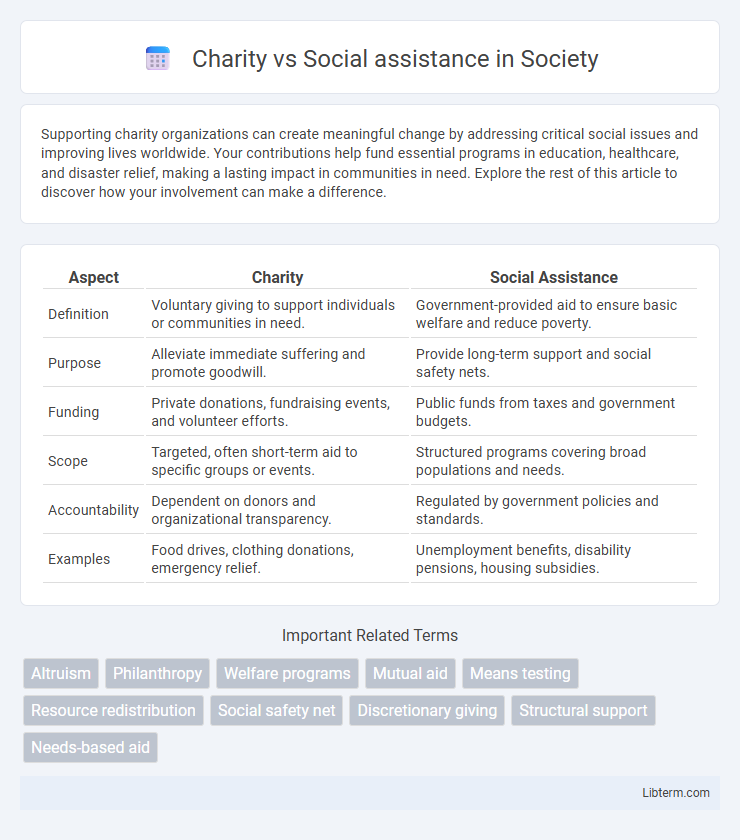Supporting charity organizations can create meaningful change by addressing critical social issues and improving lives worldwide. Your contributions help fund essential programs in education, healthcare, and disaster relief, making a lasting impact in communities in need. Explore the rest of this article to discover how your involvement can make a difference.
Table of Comparison
| Aspect | Charity | Social Assistance |
|---|---|---|
| Definition | Voluntary giving to support individuals or communities in need. | Government-provided aid to ensure basic welfare and reduce poverty. |
| Purpose | Alleviate immediate suffering and promote goodwill. | Provide long-term support and social safety nets. |
| Funding | Private donations, fundraising events, and volunteer efforts. | Public funds from taxes and government budgets. |
| Scope | Targeted, often short-term aid to specific groups or events. | Structured programs covering broad populations and needs. |
| Accountability | Dependent on donors and organizational transparency. | Regulated by government policies and standards. |
| Examples | Food drives, clothing donations, emergency relief. | Unemployment benefits, disability pensions, housing subsidies. |
Understanding Charity: Definition and Scope
Charity involves voluntary giving of resources, time, or support to address immediate needs and alleviate suffering, often driven by compassion and a sense of moral duty. It typically targets specific individuals or groups, providing direct aid such as food, clothing, or financial help without expecting returns. The scope of charity is usually short-term and individualized, contrasting with broader structural approaches aimed at systemic change.
What is Social Assistance? Key Concepts
Social assistance refers to government programs designed to provide financial support and basic needs to individuals or families facing economic hardship, ensuring a minimum standard of living. It operates through means-tested benefits, such as unemployment benefits, food stamps, and housing subsidies, aimed at reducing poverty and promoting social inclusion. Unlike charity, social assistance is a structured system based on legal entitlement rather than voluntary aid.
Historical Evolution: Charity vs Social Assistance
Charity historically emerged as voluntary, individual acts of giving rooted in religious and moral obligations, primarily addressing immediate, personal needs. Social assistance evolved as a formalized, government-led system aiming at systematic poverty alleviation through structured programs and policies. The shift from charity to social assistance marked a transition from sporadic benevolence to rights-based support emphasizing social welfare and economic stability.
Core Differences Between Charity and Social Assistance
Charity involves voluntary giving of resources, such as money or goods, driven by compassion and often targets immediate or short-term needs of individuals or communities. Social assistance is a government-funded program designed to provide systematic, ongoing support to vulnerable populations, focusing on long-term social welfare and economic stability. The core difference lies in charity being discretionary and voluntary, whereas social assistance is institutionalized, based on rights, and aimed at structural poverty reduction.
Funding Sources and Distribution Methods
Charity relies primarily on private donations, corporate sponsorships, and fundraising events to gather funds, which are then distributed directly to individuals or communities in need through grants, goods, or services. Social assistance is typically funded by government budgets sourced from taxes and public revenues, with distribution managed through structured programs such as welfare benefits, unemployment insurance, and public healthcare. The efficiency and reach of funding in social assistance depend on bureaucratic processes, while charity often offers more flexible, immediate support but with variable sustainability.
Target Beneficiaries and Eligibility Criteria
Charity primarily targets individuals or groups facing immediate hardships without stringent eligibility criteria, often providing short-term relief based on compassion and urgent need. Social assistance programs focus on low-income families and vulnerable populations, requiring applicants to meet specific eligibility criteria such as income thresholds, residency status, or disability. These criteria ensure resource allocation is systematic and aimed at long-term poverty alleviation and social welfare improvement.
Impact on Communities: Short-Term vs Long-Term Solutions
Charity often provides immediate relief by addressing urgent needs such as food, clothing, and emergency shelter, which can alleviate suffering in the short term but may not solve underlying issues. Social assistance programs focus on long-term solutions by implementing systemic changes through policy, education, healthcare, and job training, promoting sustainable community development and economic stability. Effective community impact requires balancing charitable aid for immediate support with robust social assistance that fosters lasting improvements.
Role of Government in Social Assistance Programs
The government plays a crucial role in social assistance programs by providing structured, ongoing support aimed at reducing poverty and improving social welfare through policies and funding. Unlike charity, which is often voluntary and short-term, social assistance programs are designed to ensure access to essential services such as healthcare, housing, and unemployment benefits for vulnerable populations. Government-managed distribution ensures accountability, consistency, and broader reach to address systemic social issues comprehensively.
Nonprofit Organizations and the Charity Model
Nonprofit organizations operating under the charity model focus on providing immediate relief to individuals in need through donations, volunteer efforts, and direct aid. This approach primarily addresses symptoms of social issues rather than systemic causes, relying heavily on public generosity and short-term interventions. Social assistance, in contrast, involves structured government programs designed to offer long-term support and stability through policy-driven initiatives.
Which is More Effective: Charity or Social Assistance?
Social assistance programs, often government-funded, provide structured and sustained support targeting poverty alleviation through cash transfers, healthcare, and education, making them more effective in long-term social impact than one-time charitable donations. Charity initiatives, while crucial for immediate relief, typically lack the scalability and continuity necessary to address systemic socioeconomic issues comprehensively. Studies show that social assistance reduces inequality and promotes social inclusion more efficiently by addressing root causes rather than symptoms.
Charity Infographic

 libterm.com
libterm.com